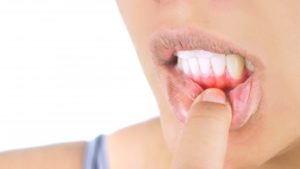February 4, 2022

According to findings from the Centers for Disease Control and Prevention (CDC), one in every two adults in the United States who are over age 30 have some form of periodontal disease. When left untreated, it can cause a variety of issues. This can be anything from tooth loss to an increased risk for diabetes and heart disease. Your dentist in Buffalo Grove may be able to help you reverse your symptoms and restore your smile to health with gum disease therapy, but this all depends on how far the issue has progressed. Continue reading to learn about the stages of periodontal disease and what this means for your oral health.
Stage 1: Gingivitis
This is the mildest form of gum disease. Symptoms often include redness, swelling, and bleeding of the gums, plus occasional bad breath. In this stage, the signs are mostly painless which is why so many people have it and are unaware. Gingivitis is the only stage of gum disease that is reversible because it has not had enough time to damage the jawbone. To get one’s smile healthy again, good oral hygiene practices and regular checkups are necessary.
Stage 2: Mild Periodontitis
Once a person reaches this second stage of gum disease, it is no longer reversible. However, it can be managed. At this point, infection of the gums has spread to the jawbone and begins the process of destroying it. The bacteria have evolved and become more aggressive, causing bone loss. This cannot simply be treated with good oral hygiene practices. It will require the help of a dentist in Buffalo Grove. Signs are increased swelling and redness, bad breath, bleeding, and probing depths (measurement of a periodontal pocket) of 4-5 millimeters.
Stage 3: Moderate Periodontitis
The effects of stage three periodontitis cannot be reversed. At this point, the probing depth has reached 6-7 millimeters. Bacteria is not only attacking the person’s bones but also their immune system and bloodstream. Treatment at this stage by a dentist includes scaling and root planing which is a technique of deep cleaning used to remove deposits of bacteria that are deep within the gums. Failure to act can lead to bone and tooth loss, gum sensitivity, increased bleeding, and shifting of teeth.
Stage 4: Advanced Periodontitis
This is the final stage of periodontal disease and occurs when the infection becomes deeper, and bacteria, once again, evolves to cause disease. Patients have a 50-90-percent chance of bone loss. Other symptoms are red, swollen gums that ooze pus, cold sensitivity, further loosening of teeth, painful chewing, and severe halitosis. This stage requires periodontal surgery or periodontal laser therapy to clean out the bacteria-filled pockets that have formed. At this point, urgent treatment is necessary or the person risks spacing or gaps between teeth, gum recession, the need for dentures, and potentially serious general health problems.
Promptly treating periodontal disease is of the utmost importance. You can protect yourself via regular dental checkups and cleanings in conjunction with good oral hygiene habits.
About the Author
Dr. Natalya Nagornaya earned her dental degree from the University of Illinois. She is an active member of the American Dental Association. Dr. Nagornaya dedicates time to seminars and continuing education courses so that she can stay current on all the latest developments in dentistry for the benefit of her patients. If you require gum disease treatment, she offers comprehensive scaling and root planing, as well as detailed periodontal charting for managing your condition if you are past the gingivitis stage. You can schedule an appointment on her website or by calling (847) 634-2525.




